Crustal Deformation & Mountains
1/53
There's no tags or description
Looks like no tags are added yet.
Name | Mastery | Learn | Test | Matching | Spaced |
|---|
No study sessions yet.
54 Terms
A horizontal line on Earth's surface has a plunge of?
0°
Stress?
Generated during orogeny can be different at various locations.
The North American craton consists of?
Shield and platform
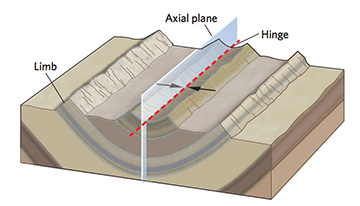
Identify the structure in the image.
Syncline
The process of mountain belt formation is called?
Orogeny
A series of anticlines and synclines forms as a result of?
Compression.
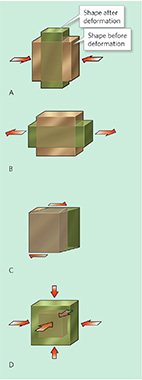
Depending on the direction of force (red arrows in the diagrams), stress is categorized as compression, tension, shear, or pressure. Which of the following diagrams shows tension?
B
Brittle deformation?
Occurs when many atomic bonds are broken quickly and rock pieces separate
The Himalayas formed by?
Collision
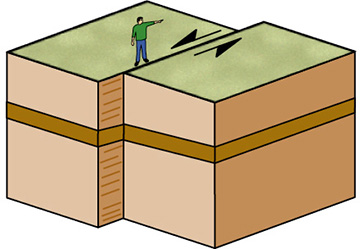
What type of fault does the diagram show?
Left-lateral strike-slip fault
The Andes Mountains are an example of mountains formed by?
Subduction
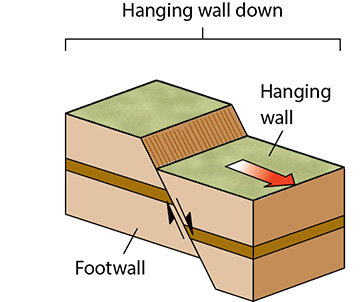
What type of fault does the diagram show?
Dip-slip fault, normal
What is the change in shape produced by stress called?
Strain
Which of the following conditions will tend to make rocks change by plastic deformation rather than by brittle deformation?
Slowly applied stress
The crust in the Basin and Range Province of Nevada, Utah, and Arizona is stretching; therefore, fault movement in this region must be?
Normal
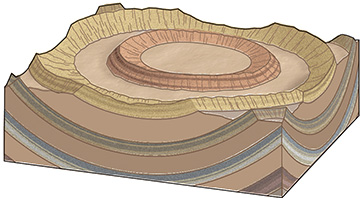
The structure pictured in the diagram is a(n)?
Basin
Where would metamorphic rocks form during mountain building?
Near plutons
Igneous rock can form during mountain building when?
Flux melting occurs at convergent boundaries.
Which of these is NOT one of the components of deformation?
Dissolution
How is stress different from strain?
Strain is the change in shape of a rock as a result of applied stress.
The distinction between joints and faults is that?
faults are fractures along which displacement has occurred; displacement does not occur along joints
What type of fault results from tension?
Normal
Right-lateral and left-lateral are both examples of __________ faults.
Strike-slip
Which process create the world's largest mountain ranges?
Converging continental plates
Under which condition would a body of rock be most likely to exhibit brittle behavior?
Low temperature
Which type of situation would be more likely to produce folds?
Warm, ductile crust under compression
The Himalayan mountain range was formed at which tectonic setting?
A convergent plate boundary
When rocks are subjected to enormous amounts of stress, they often rebound to their original shape. What is the name of this characteristic of strain?
Elasticity
What kind of stress results in the lengthening of rock?
Tensional
Normal faults are generally the result of __________ stress.
Tensional
Under which of the following conditions would a body of rock be more likely to exhibit plastic behavior?
High temperature
On a geologic map, if the contacts between sedimentary rock units form a series of parallel lines, with the youngest unit in the center, the underlying structure is a?
Non-plunging syncline
A fold shaped like an elongated arch is a(n)?
Anticline
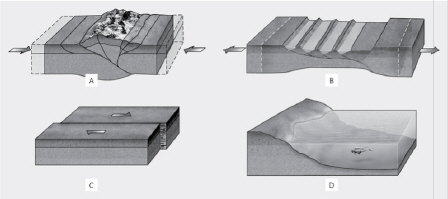
Which picture illustrates a likely outcome of compression in the crust?
A
Forces that act to elongate the crust are associated with ________.
Tension

Which of the following faults could result from both strike-slip and dip-slip stresses?
D
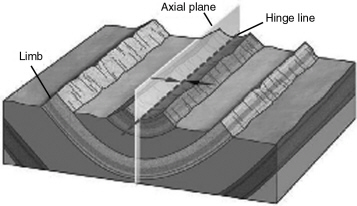
The fold in the image below is a(n)?
Syncline
What type of fault results from compression?
Reverse
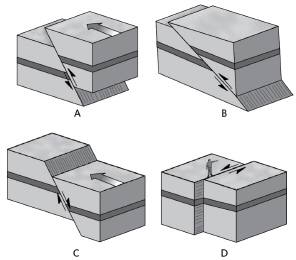
Which of the following shows a thrust fault?
B
A body of rock affected by compression will likely undergo?
Shortening
The fossil in the image below has been subjected to what type of stress?
Shear
The formation of joints in a rock in response to tension is an example of?
Brittle deformation
Which of the following is a change in the shape of a rock induced by stress?
Strain
A body of rock affected by tension will likely undergo?
Stretching
Which of the following occurs when rocks are pulled apart?
Tension
An episode of mountain building is termed a(n)?
Orogeny
Metamorphism includes a solid-state change in a rock caused by heat, pressure, and/or hydrothermal fluids. Explain what is meant by solid-state change?
A solid-state change takes place when all changes in size, shape, or composition of minerals are done while the rock remains solid. The rock does not form from a melt, nor has it been melted or weathered into a solution.
Describe the resulting metamorphism that occurs next to an igneous intrusion.
The metamorphism created by the intrusion is called thermal metamorphism or contact metamorphism and takes place in the absence of pressure. A metamorphic aureole forms next to an intrusion. Each layer of the aureole has progressively lower-grade metamorphism the farther away from the intrusion it is.
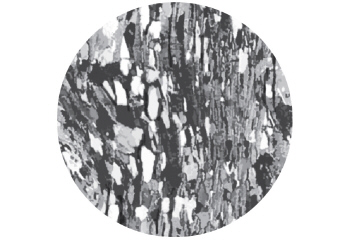
Draw the orientation of the preferential stress that created the foliation in the image below.
During dynamothermal metamorphism, several metamorphic processes are at work. Describe these processes and what effect they might have on the rocks subjected to this type of metamorphism.
Dynamothermal metamorphism occurs in the cores of mountain ranges and subjects rocks to changes in heat, pressure, and preferential stresses. Temperatures increase within the cores of mountains as a result of the geothermal gradient and igneous intrusions; this will cause changes in the mineral assemblages of the rocks including recrystallization and neocrystallization. Rocks within mountain cores are also subjected to high pressures as a result of increased overburden, compression, and shear stress. The increase in stress and pressure on the rocks will work to align minerals (by rotation and plastic deformation) to the preferred orientation and may also cause pressure solution to occur along grain boundaries.
Metamorphic grade describes the intensity or degree of metamorphism. The metamorphic grade of a rock is determined mainly by the temperature and amount of recrystallization or neocrystallization to which a rock is subjected. List the following rocks in order from low-grade to high-grade metamorphic rocks, then describe the changes seen in the suite of rocks as the grade is increased: gneiss, slate, schist, phyllite, and migmatite.
Order from low grade to high grade: slate, phyllite, schist, gneiss, and migmatite. The changes seen in these rocks as they progress from low grade to high grade are primarily in mineral assemblage and size. At the lowest grade, slate contains clay minerals that are preferentially aligned with each other (and the stress direction). As metamorphic grade increases to phyllite, the clay minerals begin to recrystallize as mica minerals; however, they remain very small. As the rock progresses to schist, the mica minerals continue to grow larger and begin to form a series of wavy layers referred to as a schistose texture (varying schistosity). In addition, it is common to have new minerals form as porphyroblasts. The jump from schist to gneiss shows a separation of light-colored and dark-colored minerals into distinct color bands. Felsic minerals such as quartz and feldspar grow larger as well. If the temperature reaches a bit past the melting point of felsic minerals, then the rock becomes a migmatite with light-colored layers of much larger felsic crystals that have been partially melted and recrystallized.
What is the difference between schist and phyllite?
Schist and phyllite are both foliated metamorphic rocks containing platy mica grains such as muscovite and biotite. Phyllite is a lower grade metamorphic rock and thus the mica grains are finer (smaller). Schist is a higher grade of metamorphic rock and thus the mica grains are coarser (larger).
What metamorphic facies would most commonly be associated with a subduction zone and why?
In subduction zones, blueschist facies rocks commonly form in accretionary prisms overlying the subducting slab. In these environments, temperatures remain relatively low and higher pressure is the main agent of metamorphism, creating blueschist facies rocks.
What is an index mineral? What do metamorphic isograds indicate? What is a metamorphic zone?
An index mineral is a mineral that forms under a specific range of metamorphic conditions and is thus reminiscent of those conditions. Isograds are lines drawn on a geologic map to indicate the location at which index minerals first appear. A metamorphic zone is the region between two isograds and represents an area of metamorphic rock of a given grade.